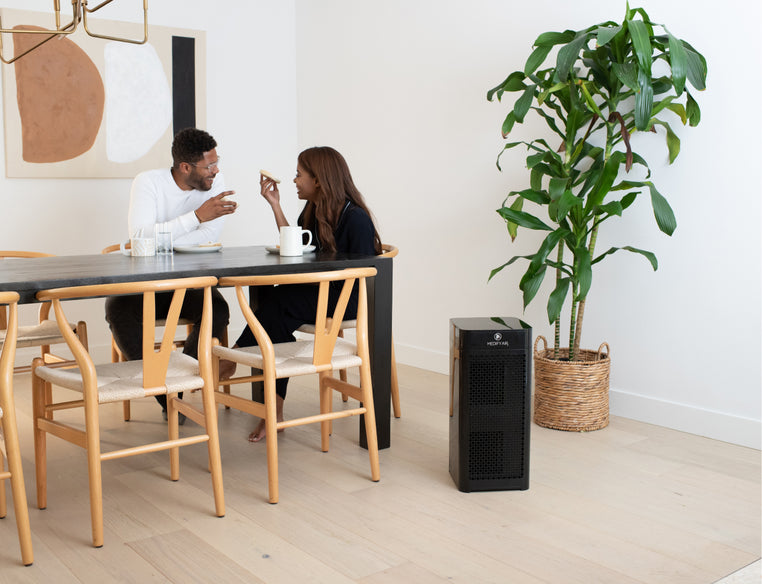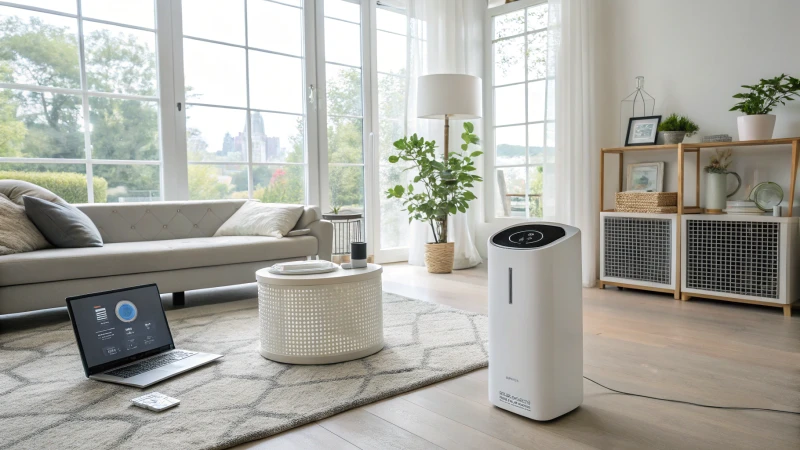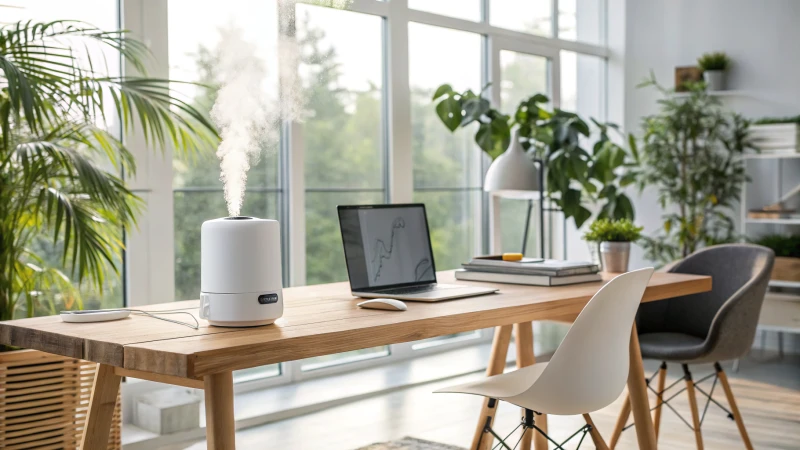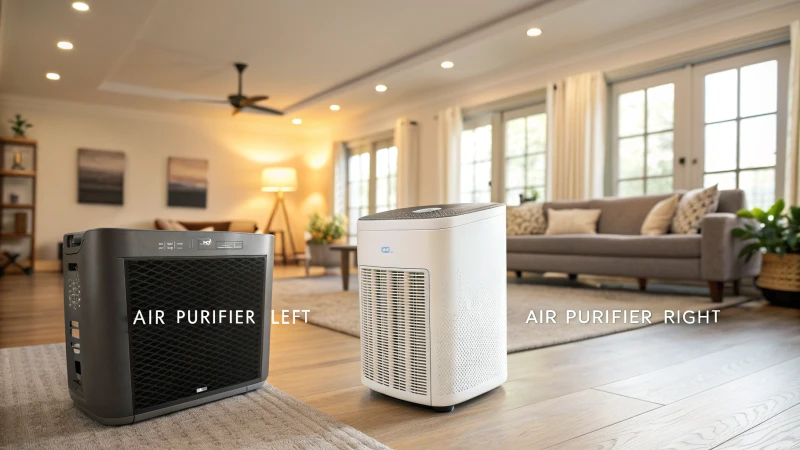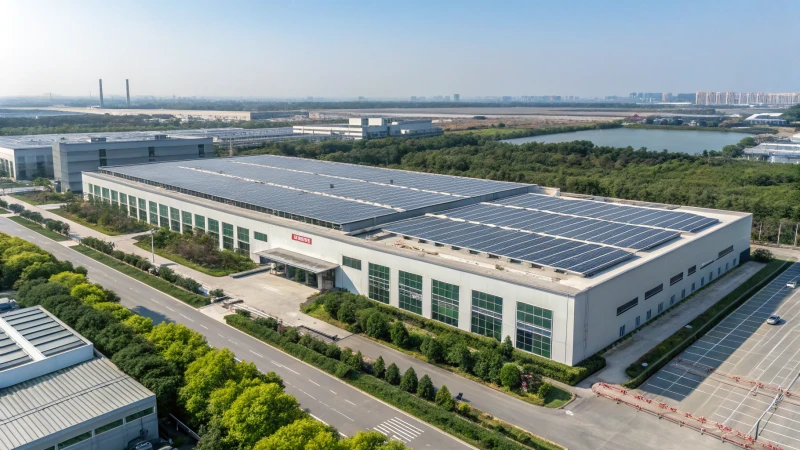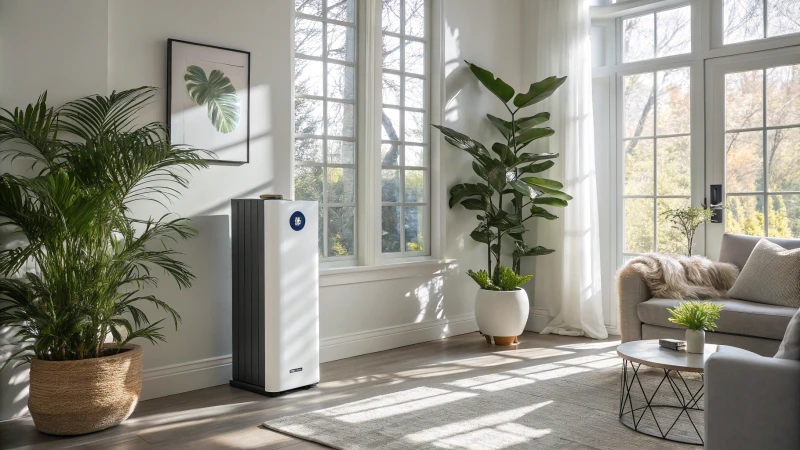
Imaginez que vous respirez de l'air frais et pur à l'intérieur de votre maison, sans aucun souci.
Purificateurs d'air muraux avec UV aident vraiment à réduire les micro-organismes tels que les bactéries et les virus. En les associant à un True HEPA augmente leur efficacité. Il faut toutefois tenir compte des risques liés aux émissions d'ozone. Donner la priorité HEPA est plus sûr et très efficace pour la purification de l'air.
J'ai d'abord pensé à utiliser UV dans mon purificateur d'air et j'étais curieux de savoir s'il promettait d'éliminer les germes. Je me suis ensuite renseignée et j'ai découvert que UV La technologie offre de bonnes choses mais présente aussi des dangers potentiels comme l'émission d'ozone. Je m'appuie sur True HEPA parce qu'ils capturent les particules de manière fiable. Ils sont très efficaces. Ce billet explore les bons et les mauvais côtés des filtres à particules. UV lumière dans les purificateurs d'air. Il vous aide à faire un choix judicieux pour votre maison.
La lumière UV des purificateurs d'air tue toutes les bactéries.Faux
La lumière UV réduit les bactéries mais ne les élimine pas complètement.
Les filtres HEPA sont plus sûrs que la lumière UV pour la purification de l'air.Vrai
Les filtres HEPA n'émettent pas d'ozone, ce qui les rend plus sûrs.
Quels sont les avantages de UV La lumière dans les purificateurs d'air ?
Avez-vous déjà réfléchi à la manière dont certains purificateurs d'air éliminent les germes gênants de l'air ? UV light technology probably plays a big role in this process. It’s like a secret weapon.
UV dans les purificateurs d'air tue les bactéries, les virus et les spores de moisissure dans l'air. Elle améliore la qualité de l'air là où les microbes posent problème. Cependant, il faut tenir compte de la production possible d'ozone. La sécurité est importante lors de l'utilisation de UV technologie.
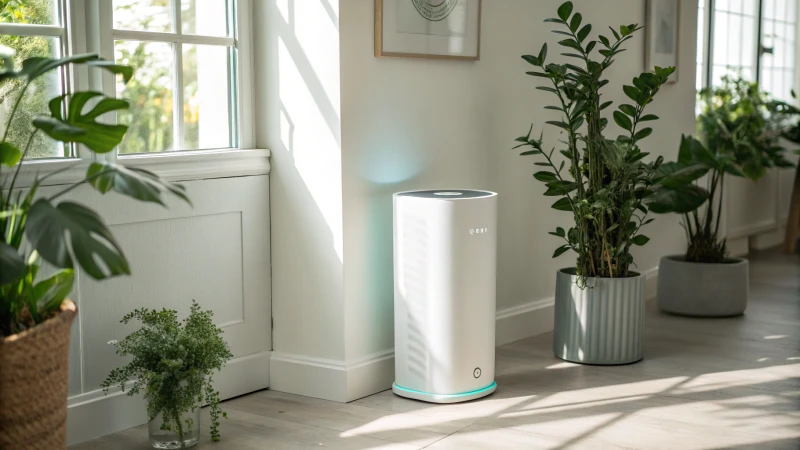
Comment UV La lumière fonctionne dans les purificateurs d'air
Imaginez que vous êtes assis chez vous et que vous respirez un air très frais. Votre fidèle purificateur d'air vous aide en utilisant UV la lumière. Il ne s'agit pas d'une lumière ordinaire. UV agit comme un petit super-héros. Elle combat les bactéries, les virus et les spores de moisissure en perturbant leur ADN, de sorte qu'ils cessent de se développer. Ce processus fonctionne très bien lorsqu'il est associé à d'autres filtres tels que HEPA des filtres.
| Avantages | Considérations |
|---|---|
| Tue les microbes en suspension dans l'air | Production potentielle d'ozone |
| Peu d'entretien | Nécessite un remplacement régulier de l'ampoule |
Efficacité par rapport à d'autres méthodes
Les purificateurs d'air sont composés de différents éléments, chacun ayant une fonction unique. HEPA retiennent la poussière, le pollen et les allergènes ; ils les attrapent comme un filet. Le charbon actif élimine les odeurs et les composés volatils qui irritent le nez. UV lumière1 cible les contaminants biologiques cachés. Ensemble, ces méthodes forment une solide équipe de purification de l'air !
- HEPA Filtres : Ils piègent très efficacement la poussière, le pollen et les allergènes.
- Carbone activé : Élimine les odeurs et les composés organiques volatils (COV).
- UV Léger : Cible et détruit les contaminants biologiques.
Sécurité et problèmes liés à l'ozone
La sécurité est importante. Quelques-uns UV peuvent produire de l'ozone, ce qui est mauvais pour les poumons. Recherchez des purificateurs qui limitent la production d'ozone ou choisissez UV-LEDs2car ils causent probablement moins de problèmes d'ozone. Le filtre du purificateur UV La lumière doit être enfermée afin d'éviter toute fuite.
- UV-LEDs : Produisent probablement moins d'ozone que les lampes au mercure.
- Chambres fermées : Tenir le UV l'éclairage en toute sécurité afin d'éviter les fuites.
Pour plus de conseils de sécurité et d'informations technologiques, consultez purification de l'air innovante3 des ressources axées sur la protection des utilisateurs.
UV La lumière dans le contexte de COVID-19
La pandémie de COVID-19 a mis en évidence l'utilisation de UV La lumière du jour est apparue au fur et à mesure que l'on s'intéressait à sa capacité à tuer les coronavirus sur les surfaces et dans l'air. Les gens ont choisi UV-pour une plus grande tranquillité d'esprit ; toutefois, si vous n'utilisez que des purificateurs d'eau de mer, vous risquez de ne pas être en mesure de les utiliser. UV La lumière ne suffit pas - elle doit faire partie d'une stratégie complète comprenant le nettoyage et la ventilation.
Pour plus d'informations sur l'utilisation de UV technologie contre les virus4Pour en savoir plus, consultez la rubrique "Recherche", qui vous aidera à décider comment l'intégrer dans votre stratégie de purification de l'air.
La lumière UV des purificateurs d'air tue les microbes en suspension dans l'air.Vrai
La lumière UV perturbe l'ADN des micro-organismes et les neutralise.
Tous les purificateurs d'air UV produisent de l'ozone nocif.Faux
Certains modèles sont conçus pour minimiser ou éliminer la production d'ozone.
Comment les vrais HEPA Filtres Comparer avec UV La lumière ?
Vous êtes-vous déjà gratté la tête en vous demandant si un vrai HEPA ou un filtre UV light is best for your air purifier? Let’s explore these two technologies to decide which fits your needs!
Vrai HEPA retiennent la poussière et les allergènes à l'aide d'une fine maille. UV La lumière du soleil cible de très petits organismes vivants tels que les bactéries et les virus. Vos besoins spécifiques en matière de purification de l'air déterminent le choix. Il est important de trouver un équilibre entre l'élimination des particules et le contrôle des agents pathogènes. Cet équilibre est crucial.
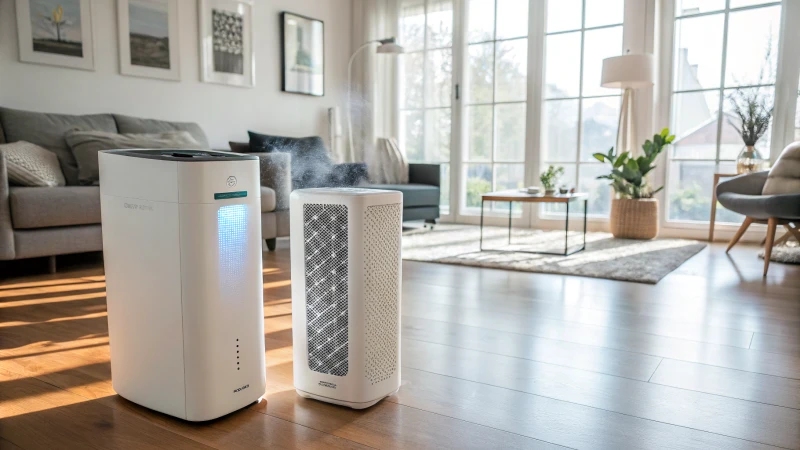
Vrai HEPA Filtres : Efficacité et sécurité
Imaginez que vous entrez dans une pièce et que vous respirez profondément, sachant que l'air est vraiment pur. Vrai HEPA filtres créent cette sensation. Ils capturent 99,97% de minuscules particules de 0,3 micron, telles que la poussière, le pollen et les poils d'animaux qui dansent dans la lumière du soleil. Pour les personnes allergiques comme moi, ces filtres sont des bouées de sauvetage. Les filtres ont parfois besoin d'être entretenus ; leur remplacement permet d'assurer le bon fonctionnement de l'appareil.
| Fonctionnalité | Vrai HEPA Filtre |
|---|---|
| Élimination des particules | 99,97% de particules ≥ 0,3 microns |
| Maintenance | Nécessite un changement de filtre |
| Sécurité | Pas de sous-produits chimiques |
UV Lumière : Neutralisation des agents pathogènes
J'ai entendu parler pour la première fois de UV lumière in air purifiers and felt curious. It’s like having a tiny hero at home, destroying unwanted germs and viruses by disrupting their DNA and making them harmless—pretty neat! However, UV la lumière ne traite pas les poussières ou les allergènes et peut produire de l'ozone, qui doit être manipulé avec précaution.
| Fonctionnalité | UV Lumière |
|---|---|
| Contrôle des agents pathogènes | Efficace sur les micro-organismes |
| Élimination des particules | Non applicable |
| Sécurité | Risque d'émission d'ozone |
Éléments à prendre en compte pour choisir la bonne technologie
Comment choisir entre les deux ? Si vous éternuez beaucoup ou si vous avez les yeux qui piquent, Vrai HEPA filtres5 peuvent être très utiles car ils sont très efficaces pour éliminer les allergènes.
Les virus vous préoccupent, peut-être pendant la saison de la grippe ou en cas de pandémie ? Dans ce cas UV systèmes d'éclairage6 peut apporter une tranquillité d'esprit supplémentaire.
La sécurité est importante ; les deux technologies sont généralement sûres, UV Les lumières peuvent créer de l'ozone - un facteur à prendre en compte.
Combiner les technologies
Certains purificateurs d'air utilisent les deux True HEPA filtres et UV pour offrir une solution solide en matière d'air pur. Cette combinaison pourrait vous intéresser si la couverture de toutes les zones - des particules aux germes - est importante. Consultez le site systèmes intégrés7 qui équilibrent ces technologies pour une qualité optimale de l'air intérieur tout en garantissant la sécurité de l'utilisateur grâce à des mesures de conception avancées.
It’s all about finding what’s best for your environment and health needs.
Les véritables filtres HEPA éliminent 99,97% des particules.Vrai
Les véritables filtres HEPA capturent 99,97% de particules aussi petites que 0,3 micron.
Les purificateurs à lumière UV éliminent la poussière de l'air.Faux
Les purificateurs à lumière UV neutralisent les agents pathogènes mais n'éliminent pas la poussière ni les allergènes.
Quels sont les risques liés à l'utilisation UV La lumière ?
Vous êtes-vous déjà demandé si l'utilisation de UV La lumière comporte des risques cachés ? Elle offre plus que son seul pouvoir de nettoyage.
Oui, en utilisant UV La lumière comporte des risques. Il s'agit notamment de lésions cutanées, de blessures oculaires et peut-être même de la production d'ozone. Il est important de prendre des mesures de sécurité. Portez un équipement de protection. Utilisez des produits certifiés. Ces mesures réduisent les risques pour la santé. Protégez-vous.
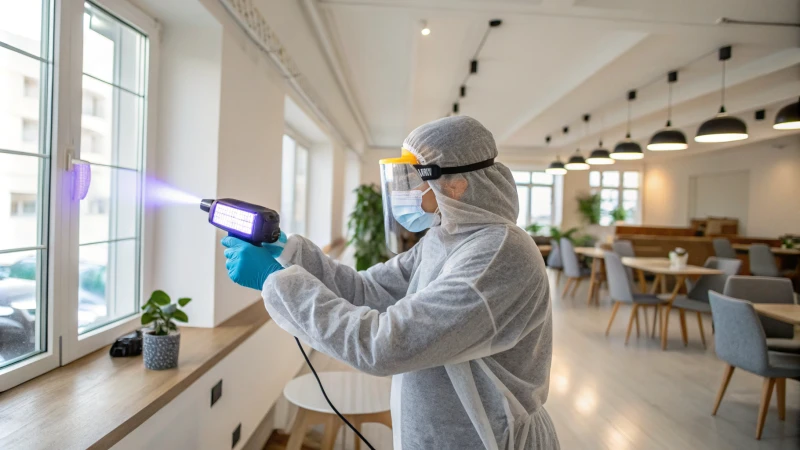
Comprendre UV Lumière
La curiosité m'amène souvent à explorer différentes technologies, et j'ai récemment découvert l'ultraviolet (UV). Imaginez que vous ayez à choisir entre les UVA, les UVB et les UVC. Chaque type de lumière présente des histoires et des dangers uniques.
| Type | Longueur d'onde | Utilisation courante | Niveau de risque |
|---|---|---|---|
| UVA | 320-400 nm | Lits de bronzage | Modéré |
| UVB | 290-320 nm | Traitements médicaux | Haut |
| UVC | 100-290 nm | Désinfection | Très élevé |
UVA8Le bronzage, souvent utilisé dans les lits de bronzage, présente des risques modérés que l'on néglige parfois. UVB9 comporte des risques plus élevés et contribue principalement aux traitements médicaux. UVC10 est très efficace pour tuer les germes, mais aussi très dangereux pour la santé humaine.
Les UVC se distinguent. Son pouvoir contre les bactéries et les virus m'impressionne, mais il comporte de sérieux dangers.
Risques pour la santé UV Exposition
Lésions cutanées
Une fois, j'ai profité d'une journée d'été ensoleillée sans crème solaire. Mauvaise idée. Ma peau a été brûlée, ce qui m'a appris une douloureuse leçon sur les dommages. UV La lumière du soleil peut avoir de nombreuses conséquences, comme des coups de soleil et même des cancers graves de la peau. Une exposition prolongée augmente le risque. Avec le temps, elle provoque même des rides et des taches de vieillesse.
Lésions oculaires
Les yeux sont très sensibles. UV light harms them easily. Photokeratitis acts like sunburn for the eyes – painful and unpleasant. Long exposure also raises the chance of getting cataracts.
Production d'ozone
Fait intéressant : certains UV Les lampes des purificateurs d'air peuvent créer de l'ozone. L'ozone en altitude est utile, mais au niveau du sol, il est nocif et aggrave les problèmes respiratoires.
Précautions de sécurité
Comment profiter UV light safely? Here’s what I learned:
- Utiliser un équipement de protection : Préparez toujours des lunettes de protection et portez des vêtements qui protègent votre peau.
- Durée limite d'exposition : Réglez des minuteries ou utilisez des systèmes automatisés pour contrôler le temps d'exposition.
- Choisissez des produits certifiés : Choisissez des appareils certifiés par des normes de sécurité fiables afin de réduire les émissions d'ozone et de garantir une utilisation sûre.
Le choix d'une certification UV est une étape très importante. Lisez attentivement les instructions et suivez les directives à la lettre.
Ces précautions permettent d'utiliser UV le pouvoir nettoyant de la lumière en toute sécurité - équilibrez la technologie et la sécurité pour vous protéger lors de ce voyage.
La lumière UVA est utilisée dans les lits de bronzage.Vrai
La lumière UVA, dont la longueur d'onde est comprise entre 320 et 400 nm, est couramment utilisée dans les lits de bronzage.
La lumière UVC est sans danger pour une exposition prolongée de la peau.Faux
La lumière UVC présente des risques importants pour la santé et n'est pas sans danger pour la peau.
Que faut-il rechercher dans un purificateur d'air mural ?
Imaginez-vous en train de respirer plus facilement et de vous sentir plus frais. Sachez que votre maison contient de l'air très pur. Le purificateur d'air mural adéquat tient cette promesse. Quels sont les éléments à prendre en compte pour faire un choix judicieux ? Explorons ensemble les points essentiels.
Choisissez un purificateur d'air mural doté d'un véritable filtre à air. HEPA Le filtre est très efficace. Ce filtre est très efficace. Il permet de nettoyer l'air en profondeur. Recherchez des modèles qui consomment peu d'énergie et fonctionnent silencieusement. Ces caractéristiques sont très importantes. Pensez aux fonctions intelligentes pour une plus grande facilité d'utilisation. Toutefois, ne choisissez pas de modèles dotés de UV la lumière. Ils peuvent créer des émissions nocives d'ozone.
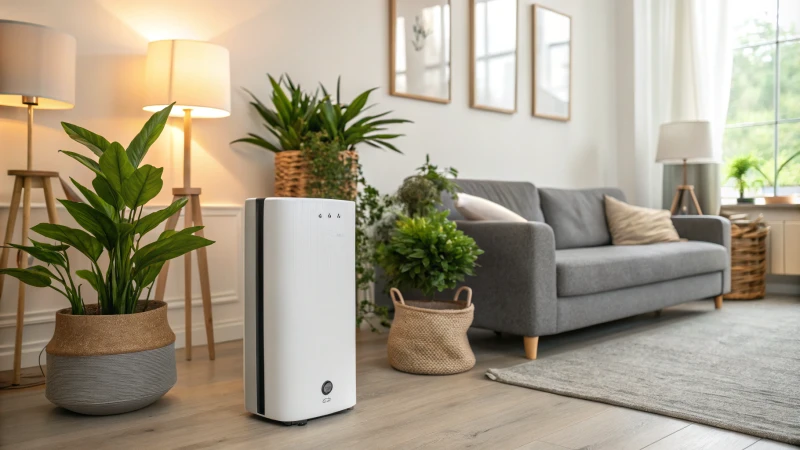
Comprendre l'efficacité de la filtration
J'ai commencé à chercher un purificateur d'air et je me suis sentie submergée par les choix. Chaque marque semblait promettre tout ce qu'elle voulait. Cependant, je me suis rapidement rendu compte que l'élément le plus important était le système de filtration. A Vrai HEPA filtre11 est devenu mon premier choix. Il capture de minuscules particules de 0,3 micron, comme la poussière et le pollen. Ces particules peuvent réellement déclencher des allergies. Ce filtre est essentiel si, comme moi, vous souffrez de problèmes respiratoires.
Efficacité énergétique et niveaux sonores
Les factures d'énergie s'envolent souvent, n'est-ce pas ? C'est pourquoi je recherche toujours la classification Energy Star. Cette classification me permet de bénéficier d'un air pur et d'économiser de l'électricité. Le bruit est une autre préoccupation. J'ai besoin de calme pour travailler ou me détendre. Certains appareils sont désormais dotés d'un Annulation des décibels™12 technologie. Ils sont silencieux, parfaits pour regarder Netflix tard dans la nuit ou dormir en toute tranquillité.
Fonctionnalités et commandes intelligentes
J'adore les gadgets. Naturellement, j'aime les modèles dotés de fonctions intelligentes. Imaginez que vous puissiez contrôler votre purificateur d'air depuis votre canapé à l'aide de votre téléphone. De nombreuses applications affichent même des mises à jour en temps réel de la qualité de l'air, ce qui me permet de savoir exactement quand augmenter les réglages.
UV La lumière : Une approche prudente
Pendant la pandémie, UV La lumière semblait fantastique. Puis j'ai appris qu'il y avait des risques pour la couche d'ozone - qui veut des problèmes respiratoires supplémentaires ? Je m'en tiens à mon fidèle HEPA et éviter de risquer une exposition à l'ozone à partir de UV caractéristiques.
| Fonctionnalité | Avantages |
|---|---|
| Vrai HEPA Filtre | Capture 99,97% des particules, pour un air plus pur |
| Label Energy Star | Réduction de la consommation d'énergie et des factures d'électricité |
| Fonctionnement à faible bruit | Offre une performance plus silencieuse, adaptée à toutes les pièces |
| Connectivité intelligente | Permet le contrôle et la surveillance à distance pour plus de commodité |
Taille et compatibilité des pièces
I’ve often bought things that didn’t fit well—it’s very frustrating! So, with air purifiers, I check that it fits my room size and has a good Clean Air Delivery Rate (CADR). This rate ensures effective air circulation without being too strong or too weak.
Choosing an air purifier shouldn’t feel too hard. By focusing on these key points, I enjoy cleaner indoor air and avoid unnecessary risks or hassles.
Les véritables filtres HEPA capturent 99,97% des particules.Vrai
Les véritables filtres HEPA sont conçus pour capturer des particules aussi petites que 0,3 micron.
L'utilisation de la lumière UV dans les purificateurs est toujours sans danger.Faux
La lumière UV peut émettre de l'ozone, qui peut provoquer des problèmes respiratoires et exacerber l'asthme.
Conclusion
Purificateurs d'air muraux avec UV La lumière peut réduire les micro-organismes mais peut émettre de l'ozone. C'est vrai HEPA sont plus sûrs et plus efficaces pour la purification de l'air sans les risques associés.
-
Comparer les avantages de la lumière UV et des filtres HEPA en matière de purification de l'air. ↩
-
Découvrez le mécanisme par lequel la lumière UV perturbe l'ADN des microbes nuisibles. ↩
-
Découvrez les modèles et les pratiques qui privilégient la sécurité avec une production minimale d'ozone. ↩
-
Découvrez les études sur la façon dont la technologie UV réduit la propagation des virus à l'intérieur des bâtiments. ↩
-
Découvrez pourquoi les filtres True HEPA sont privilégiés pour le soulagement des allergies en éliminant efficacement les allergènes. ↩
-
Understand the mechanism behind UV light’s effectiveness in neutralizing airborne pathogens. ↩
-
Découvrez les purificateurs d'air qui offrent une double approche avec les technologies HEPA et UV. ↩
-
Comprendre les différents types de lumière UV permet de choisir la bonne application pour une utilisation en toute sécurité. ↩
-
Découvrez les effets de l'exposition aux UV sur la santé de la peau pour mieux vous protéger. ↩
-
La connaissance de ces normes vous permet de sélectionner des produits sûrs qui minimisent les risques pour la santé. ↩
-
Understanding True HEPA filters ensures you’re choosing an air purifier capable of high-efficiency filtration. ↩
-
Découvrez comment la technologie Decibel Cancellation™ contribue à un fonctionnement plus silencieux pour un environnement plus confortable. ↩


